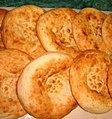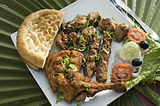Naan/ja: Difference between revisions
Created page with "ナン" |
Created page with "最も古い英語での使用例は、ウィリアム・トゥークによって1803年に書かれた旅行記に見られる。トゥークや他の初期の資料では「nan」と綴られていたが、1970年代以降「naan」という綴りが優勢となっている。" |
||
| (8 intermediate revisions by the same user not shown) | |||
| Line 1: | Line 1: | ||
<languages /> | <languages /> | ||
{{Infobox food/ja | |||
{{Infobox food | |||
| alternate_name = Nan, Noon, Paan, Faan | | alternate_name = Nan, Noon, Paan, Faan | ||
| image = Annapurna_Naan.jpg | | image = Annapurna_Naan.jpg | ||
| Line 8: | Line 6: | ||
| caption = | | caption = | ||
| country = | | country = | ||
| region = [[Asian cuisine| | | region = [[Asian cuisine/ja|アジア]] | ||
| creator = | | creator = | ||
| course = | | course = | ||
| served = | | served = | ||
| main_ingredient = [[Flour]], [[yeast]], [[Edible salt| | | main_ingredient = [[Flour/ja|小麦粉]], [[yeast/ja|酵母]], [[Edible salt/ja|塩]], [[sugar/ja|砂糖]], [[ghee/ja|ギー]], [[water/ja|水]] | ||
| variations = | | variations = | ||
| calories = | | calories = | ||
| other = | | other = | ||
}} | }} | ||
''' | '''ナン''' ({{IPAc-en|n|ɑː|n}}) は、[[Leavening/ja|発酵させた]]、オーブンで焼くか[[tava/ja|タワー]]で焼いた[[flatbread/ja|平たいパン]]であり、[[tandoor/ja|タンドール]]で焼くこともできる。軽くふわふわした食感と、焼成過程でできる黄金色の斑点が特徴である。ナーンは[[Iranian cuisine/ja|ペルシア]]、[[Central Asian cuisine/ja|中央アジア]]、[[South Asian cuisine/ja|南アジア]]、[[Southeast Asian cuisine/ja|東南アジア]]、および[[Caribbean cuisine/ja|カリブ海]]の料理に見られる。 | ||
白色または小麦粉で構成され、通常は酵母といった発酵剤と組み合わせられることで、ナンの生地には空気のポケットが形成され、そのふわふわで柔らかな食感に寄与する。ナンを作るための追加の材料には、温水、塩、[[ghee/ja|ギー]]、[[yogurt/ja|ヨーグルト]]があり、牛乳、卵、蜂蜜などを加える場合もある。酵母の代わりにベーキングパウダーや重曹を用いることで、パンの準備時間を短縮することもできる。 | |||
タンドールを使用する焼成過程では、ナンの生地は丸められ、平たく伸ばされ、内部の壁に押し付けられる。内部の温度は最大480 °C (900 °F) に達することがあり、この方法によりパンは数分で焼き上がり、強烈な熱によって斑点状の焼き色を得ることができる。ナンは[[tava/ja|タワー]]を使ってコンロの上でも調理できる。鍋を火の上で逆さまにして、パンの表面に焼き色を付けることもできる。 | |||
焼き上がった後、ナンは[[ghee/ja|ギー]]またはバターで塗られ、温かいうちに供される。この柔らかくしなやかなパンは食事に添えられ、ソース、シチュー、カレーをすくい取るための食器の代わりとなるほか、タンドリーチキンのような乾いた料理とともに提供される。 | |||
==語源== | |||
[[File:Naan Bakery, Iran, Qajar era (circa 1850).jpg|thumb|[[:en:Iran|イラン]]のカージャール朝時代(1850年頃)のナンのパン屋]] | |||
[[File:Naan Bakery, Iran, Qajar era (circa 1850).jpg|thumb| | |||
「ナン」という語は、[[:en:Persian language|ペルシア語]]の''nân'' ({{langx|fa|نان}}) に由来し、あらゆる種類のパンを意味する一般的な語である。 | |||
最も古い英語での使用例は、[[:en:William Tooke|ウィリアム・トゥーク]]によって1803年に書かれた旅行記に見られる。トゥークや他の初期の資料では「nan」と綴られていたが、1970年代以降「naan」という綴りが優勢となっている。 | |||
<div lang="en" dir="ltr" class="mw-content-ltr"> | <div lang="en" dir="ltr" class="mw-content-ltr"> | ||
| Line 110: | Line 95: | ||
</div> | </div> | ||
==関連項目== | |||
{{div col|colwidth=15em}} | {{div col|colwidth=15em}} | ||
* [[Iranian cuisine#Bread| | * [[Iranian cuisine/ja#Bread|イランのナン]] | ||
** [[Sangak]] | ** [[Sangak/ja]] | ||
** [[Taftan (bread)| | ** [[Taftan (bread)/ja|タフトゥーン]] | ||
** [[Barbari bread| | ** [[Barbari bread/ja|バルバリー]] | ||
** [[Lavash]] | ** [[Lavash/ja]] | ||
* [[Tandoor bread]] | * [[Tandoor bread/ja]] | ||
** ''[[Tandoori roti]]'' | ** ''[[Tandoori roti/ja]]'' | ||
** ''[[Tandoori paratha]]'' | ** ''[[Tandoori paratha/ja]]'' | ||
** ''[[Tandyr nan]]'' | ** ''[[Tandyr nan/ja]]'' | ||
* ''[[Bazlama]]'' | * ''[[Bazlama/ja]]'' | ||
* [[Shotis puri]] | * [[Shotis puri/ja]] | ||
* [[Tonis puri]] | * [[Tonis puri/ja]] | ||
* ''[[Matnakash]]'' | * ''[[Matnakash/ja]]'' | ||
* ''[[Paratha]]'' | * ''[[Paratha/ja]]'' | ||
* ''[[Parotta]]'' | * ''[[Parotta/ja]]'' | ||
* [[Afghan bread]] | * [[Afghan bread/ja]] | ||
* [[Indian breads]] | * [[Indian breads/ja]] | ||
* [[Pakistani breads]] | * [[Pakistani breads/ja]] | ||
* [[List of Pakistani breads]] | * [[List of Pakistani breads/ja]] | ||
* [[List of Indian breads]] | * [[List of Indian breads/ja]] | ||
{{div col end}} | {{div col end}} | ||
{{Navboxes|list= | {{Navboxes|list= | ||
{{Bangladeshi dishes}} | {{Bangladeshi dishes/ja}} | ||
{{Pakistani dishes}} | {{Pakistani dishes/ja}} | ||
{{Pakistani bread}} | {{Pakistani bread/ja}} | ||
{{Indian Dishes}} | {{Indian Dishes/ja}} | ||
{{Indian bread}} | {{Indian bread/ja}} | ||
{{Iranian cuisine}} | {{Iranian cuisine/ja}} | ||
{{Iranian bread}} | {{Iranian bread/ja}} | ||
{{Burmese cuisine}} | {{Burmese cuisine/ja}} | ||
{{Indonesian cuisine}} | {{Indonesian cuisine/ja}} | ||
{{Indonesian bread}} | {{Indonesian bread/ja}} | ||
{{Egyptian cuisine}} | {{Egyptian cuisine/ja}} | ||
{{Flatbreads}} | {{Flatbreads/ja}} | ||
{{Bread}} | {{Bread/ja}} | ||
}} | }} | ||
{{Subject bar|auto=1|cookbook=Naan|Afghanistan|Iran|India|Pakistan|Middle East|Food}} | {{Subject bar|auto=1|cookbook=Naan|Afghanistan|Iran|India|Pakistan|Middle East|Food}} | ||
[[Category:Afghan cuisine]] | [[Category:Afghan cuisine]] | ||
Revision as of 10:15, 3 September 2025
| Naan/ja | |
|---|---|
 | |
| 別名 | Nan, Noon, Paan, Faan |
| 地域 | アジア |
| 主な材料 | 小麦粉, 酵母, 塩, 砂糖, ギー, 水 |
|
| |
ナン (/nɑːn/) は、発酵させた、オーブンで焼くかタワーで焼いた平たいパンであり、タンドールで焼くこともできる。軽くふわふわした食感と、焼成過程でできる黄金色の斑点が特徴である。ナーンはペルシア、中央アジア、南アジア、東南アジア、およびカリブ海の料理に見られる。
白色または小麦粉で構成され、通常は酵母といった発酵剤と組み合わせられることで、ナンの生地には空気のポケットが形成され、そのふわふわで柔らかな食感に寄与する。ナンを作るための追加の材料には、温水、塩、ギー、ヨーグルトがあり、牛乳、卵、蜂蜜などを加える場合もある。酵母の代わりにベーキングパウダーや重曹を用いることで、パンの準備時間を短縮することもできる。
タンドールを使用する焼成過程では、ナンの生地は丸められ、平たく伸ばされ、内部の壁に押し付けられる。内部の温度は最大480 °C (900 °F) に達することがあり、この方法によりパンは数分で焼き上がり、強烈な熱によって斑点状の焼き色を得ることができる。ナンはタワーを使ってコンロの上でも調理できる。鍋を火の上で逆さまにして、パンの表面に焼き色を付けることもできる。
焼き上がった後、ナンはギーまたはバターで塗られ、温かいうちに供される。この柔らかくしなやかなパンは食事に添えられ、ソース、シチュー、カレーをすくい取るための食器の代わりとなるほか、タンドリーチキンのような乾いた料理とともに提供される。
語源

「ナン」という語は、ペルシア語のnân (Persian: نان) に由来し、あらゆる種類のパンを意味する一般的な語である。
最も古い英語での使用例は、ウィリアム・トゥークによって1803年に書かれた旅行記に見られる。トゥークや他の初期の資料では「nan」と綴られていたが、1970年代以降「naan」という綴りが優勢となっている。
Varieties
Indian subcontinent
Naan spread to the Indian subcontinent during the Islamic Delhi Sultanate period. The earliest mention of naan in the region comes from the memoirs of Indo-Persian Sufi poet Amir Khusrau living in India during the 1300s AD. Khusrau mentions two kinds of naan eaten by Muslim nobles; Naan-e-Tunuk and Naan-e-Tanuri. Naan-e-Tunuk was a light or thin bread, while Naan-e-Tanuri was a heavy bread and was baked in the tandoor. During India’s Mughal era in the 1520s, naan was a delicacy that only nobles and royal families enjoyed because of the lengthy process of making leavened bread and because the art of making naan was a revered skill known by few. The Ain-i-Akbari, a record of the third Mughal emperor’s reign, refers to naan being eaten with kebabs or kheema in it. By the 1700s, naan had reached the masses in Mughal cultural centers in South Asia.
Indonesia
In Indonesia, naan is a popular alternative to rice among the Indians, Arabs, Malays, Acehnese and the Minangkabaus, similar though not the same as roti or roti canai which was introduced from Tamils. This dish is known as roti naan or roti nan, and is cooked using Indonesian spices such as garlic.
Myanmar
Naan bya (Burmese: နံပြား) in Myanmar is traditionally served at teahouses with tea or coffee as a breakfast item. It is round, soft, and blistered, often buttered, or with creamy pè byouk (boiled chickpeas) cooked with onions spread on top, or dipped with Burmese curry.
| External image | |
|---|---|
China
The Jingzhou style of guokui, a flatbread prepared inside a cylindrical charcoal oven much like a tandoor, has been described as "Chinese naan". It is also an integral part of Uyghur cuisine and is known in Chinese as 饢 (náng).
Japan
After being promoted by Kandagawa Sekizai Shoukou in 1968, which is now the sole domestic manufacturer of tandoors, naan is now widely available in Indian-style curry restaurants in Japan, where naan is typically free-flow. Some restaurants bake ingredients such as cheese, garlic, onions, and potatoes into the naan, or cover it with toppings like a pizza.
Georgia
Shotis puri is a popular flat bread eaten in Georgia and cooked by sticking dough to the sides of a tandoor-like clay oven called a tone.
Elsewhere
In 1799, the word naan was introduced into the English language by historian and clergyman William Tooke. Today, naan can be found worldwide in restaurants serving South Asian and Middle Eastern cuisine, and it is available in many supermarkets. Fusion cuisine has introduced new dishes that incorporate naan, including naan pizza and naan tacos and even huevos rancheros (an egg dish) served over naan. Naan pizza is a type of pizza where naan is used as the crust instead of the traditional pizza dough. Chefs such as Nigella Lawson, and supermarkets such as Wegmans offer recipes for people to make their own naan pizza at home, though it is certainly not traditional.
Gallery
-
Nan in Afghanistan
-
Nan in Kabul, Afghanistan
-
Nan in Mazar-e Sharif, Afghanistan
-
A Uyghur naan store in Ürümqi, China
-
Nan in Iran
-
Nân-e barbari in Iran
-
Nân-e sangak in Iran
-
Nân-e tâftun in Iran
-
Butter garlic naan
-
Paneer (cheese) naan
-
Burmese nan bya
関連項目
| この記事は、クリエイティブ・コモンズ・表示・継承ライセンス3.0のもとで公表されたウィキペディアの項目Naan(28 August 2025, at 10:07編集記事参照)を翻訳して二次利用しています。 |















